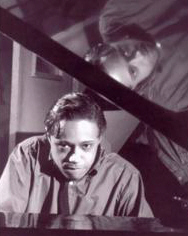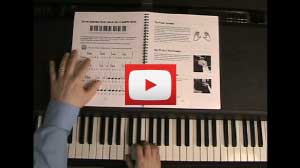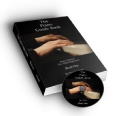Hard Bop Pianists:
Horace Silver, Wynton Kelly, Bobby Timmons, Red Garland, and Tommy Flanagan
For the hard bop pianists, the feeling was all about the groove. These players embraced tradition, and looked for new approaches to jazz piano. Standards and blues were once again a driving force in jazz, and now gospel and R&B were also part of the mix. Hard bop pianists took the innovations of Bud Powell and Monk, then added in the new flavors to their improvisations.
This new style was best suited for the small ensemble, often consisting of a piano trio plus a tenor sax and trumpet. The hard bop pianist was usually the only chordal instrument in the band, and they typically played a supportive role, that is until their solo section! Here are just a few hard bop pianists...
Horace Silver, 1928-2014

Horace Silver was born and raised in Norwalk, CT, to parents of Cape Verdean descent who were both musicians. His father played guitar in a group with his brothers, playing their native folk songs, which had a "bossa" feel. Horace tagged along to many of these gigs, soaking up the music. He played saxophone through his school years, but upon graduation he was forced to stop playing sax because of a problem with his spine. So, at 19, Horace started playing piano.
Horace developed his hard bop piano style quite quickly. In 1951 he got a gig in Hartford accompaning saxophonist Stan Getz, who was so impressed with his playing that he took him on the road. A year later Horace Silver moved to New York, and was soon in demand. He got work with Coleman Hawkins, Lester Young, and others. He soon hooked up with Art Blakey collaborating as the house band at Minton's, the club where bop was born. They called their band "The Jazz Messengers." Later Silver would amicably move on, and Blakey would appropriate the "Messengers" name.
Horace got a record deal with Blue Note in 1952, and would remain with that label for the next 28 years, becoming a huge influence on jazz.
Horace Silver was the first of the "hard bop pianists." He was the first to mix the R&B, blues and gospel with jazz; and would have a major impact on American music through his immence influence on Ray Charles. He perfected the tenor sax/trumpet combination which would become the standard jazz band configuration. Also, he brought the listeners back into jazz with catchy melodies and funky grooves.
Though limited in technical ability, Horace Silver's impact is immeasurable. He rarely played anything other than his own excellent compositions, many of which have become jazz standards today. These include "Song For My Father," "Doodlin'," "Senor Blues," "The Preacher," "Peace" and "Sister Sadie."
Wynton Kelly, 1931-1971
Wynton Kelly was born in Jamaica, but was raised in Brooklyn, N.Y. He started piano lessons at age four, and attended the Music & Arts High School in Manhattan.
Wynton Kelly was gigging by the time he was 13, and had played with Hot Lips Page, Eddie "Cleanhead" Vinson, Johnny Moore's Three Blazers and Eddie "Lockjaw" Davis, all before he was 20.
In 1951, he did his first session for Blue Note Records as a leader, and later started touring with Dinah Washington and with Dizzy Gillespie. He spent two years in the Army, but returned as one of the most in-demand pianists in New York in 1954, playing with Hank Mobley, Johnny Griffin, Sonny Rollins and Billie Holiday.
In 1959, Wynton replaced Bill Evans in the Miles Davis quintet, performing on Kind of Blue, the best-selling jazz record of all time. In the early sixties, he started his own trio with bassist Paul Chambers and drummer Jimmy Cobb, both also Miles Davis alum. This trio would later team up with guitarist Wes Montgomery for a few years.
Wynton Kelly will be remembered as a hard bop pianist with an easy-going bluesy feel. His style has been described as "light and bouncy" and a "happy sound" but with a "late night blues" quality.
Wynton Kelly died of an epileptic fit shortly after a session with Joe Henderson in 1971.
Bobby Timmons, 1935-1974
Bobby Timmons was born in Philadelphia, P.A., and raised by his grandfather. He started piano lessons at age six, and later recieved a full scholarship to the Philadelphia Academy of Music. Trained in the classics, Bobby would also play gospel at church services. He got into jazz at age 17, listening to Art Tatum, Fats Waller, and Bud Powell.
Bobby moved to New York in 1954, and was soon working with greats like Kenny Dorham, Chet Baker, Sonny Stitt and Maynard Ferguson. He played in Art Blakey's Jazz Messengers from 1958 to 59, recording one of his best known tunes, "Moanin'." He later joined with Cannonball Adderly's band.
Because of a problem with alchohol, Bobby's playing declined. He was one of the first with his "soul-jazz" groove, and was later embittered by the comparative lack of success he had while others had copied his sound. Timmons will be remembered for his unhurried, laid-back gospel groove with a blusey feel. Along with "Moanin," his compositions "This Here" and "Dat Dere" have become jazz standards.
Bobby Timmons died of cirrhosis of the liver in 1974.
Red Garland, 1923-1985
Red Garland was born, raised and died in Dallas, Texas. Like Horace Silver, he came to the piano rather late in life. He played alto saxophone through high school, and was not particularly interested in piano. He joined the Army and was stationed in Texas with John Lewis, the pianist to later start the Modern Jazz Quartet. He heard Lewis play, was hooked, and started studying informally with him.
Shortly after his service stint was over, he got a local gig with Hot Lips Page, who took him on the road, which brought Red to New York. In 1946 he landed in Billy Ekstine's big band, which was an incubator for be bop. Some of the band members included Charlie Parker and Dizzy Gillespie. He also started hanging out with Art Tatum and Bud Powell, who were both big influences. He gigged with Coleman Hawkins, Charlie Parker and Lester Young.
In '55, he joined the Miles Davis Quintet on John Coltrane's recommendation. This Davis group made some great jazz albums, including Milestones which features Red doing a hard swinging trio version of the children's song "Billy Boy."
He later left Miles to go out on his own, but could not reach the level of success that he wanted. He quit the business in 1968 and moved back to Dallas, only occasionally playing and touring.
Red Garland's legacy is his consistently high level of swinging and boppin'. His recorded output, especially from the 50's is unparralled in its inventive ideas, left hand comping, and singular right hand lines. His style defines what a hard bop pianist plays.
Red Garland played his last gig in Dallas in 1982.
Tommy Flanagan, 1930-2001
Tommy Flanagan grew up in Detroit, Michigan, and began piano lessons at age 10. Like many of his contemporaries, he learned from the classics, but learned jazz from copying the piano rolls of Fats Waller and the recordings of Teddy Wilson. Tommy worked steadily in Detroit, but made his way to New York in 1956, with his guitarist friend Kenny Burrell.
Flanagan was soon one of the most in demand hard bop pianists, and within weeks of arriving in New York was recording with Miles Davis. He can be heard on many major recordings including John Coltrane's Giant Steps. Tommy played with "almost everyone" during the 50's, 60's and 70's, including 16 years as Ells Fitzgerald's accompanist. In 1966 he moved to Los Angeles, and would later "retire" in Pheonix, Arizona. In his later years he played occasional solo concerts on short tours.
Like another Detroit pianist, Hank Jones, Tommy Flanagan was the consummate accompanist: always striving to make the leader sound great. His playing was controlled, unhurried, and always swinging. He delivered a steady level of consistency, but still kept a creative spark in his playing.
Start Playing Piano Today with the Piano Guide Quick Start Course!
Easy to follow step-by-step lessons designed for adult beginners. The next best thing to private lessons!
What You'll Learn:
- Notes on the piano/keyboard
- Proper fingering
- C major scale
- Chords
- How to read music
- And much more!

Video lessons - watch as I play everything for you.

